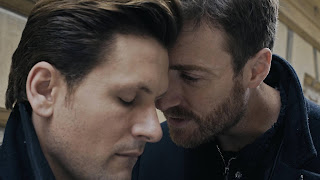Movie Review - The Zero Theorem
 |
The second location is the unnamed city street that Qohen has to traverse to get to work, including the park, which is the only other exterior location beyond the city street. It's unnamed but a European structure is evident. On top of it are futuristic flourishes. Gilliam's landscape is not unlike Spielberg's Minority Report, which imagines city centers that are inundated with an even greater bombardment of interactive advertising. Gilliam's landscape is more clownishly colorful and splashy. A drab and dull, possibly gray, European street is gone over with Crayola, CGI crayons, done so with appropriate references in an attempt to be a satire of the digital, millennial age, and the culture of those 30-years and under.
Gilliam continues his spoof of the modern era with the third location, which is the office space and possible headquarters of Mancom. One can't look at the way this location is laid out and how it's manifested and populated, and think that it's not a riff on the office space of Facebook or Google or other Silicon Valley companies. Gilliam can't help but infuse a circus ring-like aesthetic to everything as well. There's perhaps something to be said about the fact that the workers engage by what looks like playing video games.
Two-time Oscar winner Christoph Waltz (Inglorious Basterds and Django Unchained) plays Qohen Leth. Every time he does his so-called work, it looks like he's playing an Xbox and the most-advanced form of Tetris ever. The blocks have complicated, mathematical equations on them. He has a cubicle at Mancom, but he prefers to work at home. Yet, his supervisor Joby, played by David Thewlis (Harry Potter and the Prisoner of Azkaban and Naked), invites him to a fourth location for a crazy party where he meets the owner of Mancom, an unnamed man, played by Matt Damon.
There are sight gags up until Qohen arrives at this gathering, which is part rave, part costume party. One of the sight gags is Damon's outfits, which magically match whatever he's near. It's magical camouflage or chameleon clothing. For example, he sits in a chair, wrapped in zebra-striped fabric, so Damon's suit is also zebra-striped, allowing him to perfectly blend.
The party scene also really emphasizes the physical comedy that becomes fairly regular for the rest of the film. Waltz handles the slapstick and pratfalls with aplomb. A lot of the other comedy comes from quirky or sheer, wacky characters. Mélanie Thierry plays Bainsley, an aggressive seductress. Lucas Hedges plays Bob, the teenage computer-genius and Tilda Swinton is an interactive psychiatrist program, similar in tone to her character in Snowpiercer.
The humor mostly carries the movie from scene-to-scene, and location-to-location, including the fifth and final location, a tropical beach with a perpetual sunset. Unlike Gilliam's 12 Monkeys or Brazil, which this movie mimics most of all, there isn't much of a plot or narrative thrust. Most movies are propelled with the protagonist wanting to get something, an active motive. The screenplay by Pat Rushin doesn't give Qohen an active motive. All he wants is to be left alone and wait for an ethereal phone call.
As to say, Qohen wants nothing. When the main character wants nothing, that can stifle a movie. What helps this movie is that Qohen's desire to be left alone is interrupted with people constantly who can't leave him alone. This contradiction isn't played up as much as it could or should. Therefore, Qohen is an interesting and funny character who acknowledges he has no purpose but that acknowledgement isn't enough.
The movie comes to an end, and, like the math equations on which Qohen works, it adds up to nothing. It tries to cram a love story into it and then pull the rug away, but it doesn't work.
Two Stars out of Five.
Rated R for language and some sexuality/nudity.
Running Time: 1 hr. and 47 mins.










Comments
Post a Comment